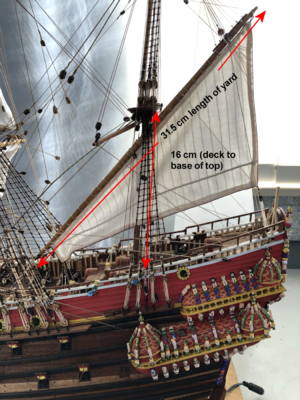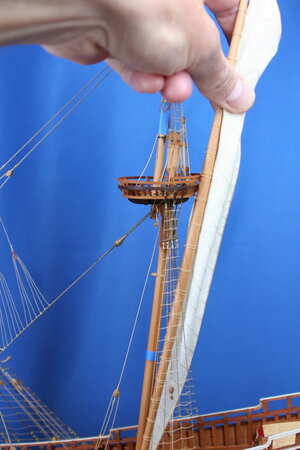Hi Paul,
Sorry to hear that the mizzen yard is out of scale. It's hard to understand how a kit manufacturer could get it that wrong.
To help and as a guide, my Billing's Vasa has a mizzen yard length of 31.5 cm and is at a scale of 1/75. The De Agostini Vasa is at a scale of 1/65, so in theory, the correct length for your mizzen yard at your scale should be:
Length of mizzen yard = 31.5 x 75 / 65 = 36.35 cm = 14.31 inches.
So your guess at the length was not too far off. While this might help with getting the length correct, it doesn't help with the amount of work required. Very frustrating and a lot of time required to remedy the error, but as everyone has said, we all learn from our mistakes (albeit the manufacturer's mistake)!!!!
Oh, by the way Paul, I remember when rigging my mizzen sail and yard, the issue of which side of the mizzen mast is it rigged, came up. I still have not had a satisfactory answer to this question. I have mounted mine on the port side of the mizzen mast, which is fine for a starbord tack (ie wind over the starbord beam), but what happens for a port tack? The sailor's could not have left the mizzen yard on the port side as the sail would have been pushed by the wind onto the mast, so somehow, I assume the yard must have been moved onto the starboard side of the mast. To do this, I can only see this being done by lowering the yard, moving it aft of the mizzen mast, and then moving it to the starbord side??? The various lines for the sail would get tangled and it's not a small sail - I just don't know how it was mechanically done.
On a more modern sailing yacht which has a mizzen mast, say a ketch, the mizzen sail or 'spanker', is all aft of the mizzen mast (usually mounted to a boom and maybe a gaff at the head of the sail) and so the sail can rotate across the ship as the tack changes from port to starboard and back again. This however was not the arrangement of the Vasa where a significant portion of the yard and sail is forward of the mizzen mast.
So, in the end, you are going to have to make a decision as to whether your Vasa is on a port or a starbord tack.....
Regards,
PeterG






 .
.


 when I read, "Once I measured (and remeasured, and remeasured, and then after that I remeasured)". Not because I'm insensitive, but because I've been there and done that. You are not alone Paul! It's a shame, with your quality of work you can't use the first yard in some way.
when I read, "Once I measured (and remeasured, and remeasured, and then after that I remeasured)". Not because I'm insensitive, but because I've been there and done that. You are not alone Paul! It's a shame, with your quality of work you can't use the first yard in some way. 

